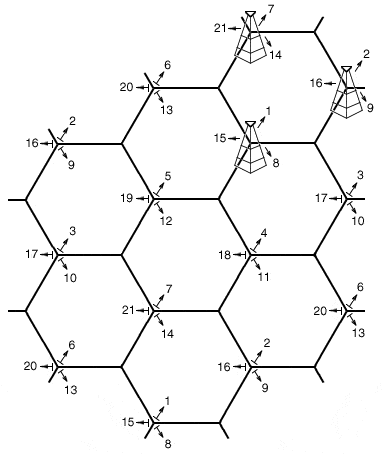Cell in wireless communication refers to a specific geographic area covered by a cell tower (or base station) in a cellular network. Each cell provides network coverage to mobile devices within its area, enabling seamless wireless communication. This web of cells forms the backbone of our daily communication, allowing us to stay connected as we move about.
In this article, we’ll explore the fundamentals of cellular networks, delve into the structure and function of cells, examine different types of cells and their applications, and discuss the handover process that keeps connections alive as users move. Additionally, we’ll look at the challenges in cell planning and optimization, and anticipate the future of cellular networks in the context of emerging technologies.
Table of Contents:
- Introduction to Cellular Networks
- Cell Structure and Function
- Types of Cells
- Handover Process
- Cell Planning and Optimization
- References

1. Introduction to Cellular Networks
The evolution of cellular networks marks a revolutionary stride in the domain of wireless communication. At its core, a cellular network is a complex system of interconnected cells, each served by a base station, that enables mobile phones, tablets, and other wireless devices to communicate seamlessly.
Fundamentals of Cellular Networks
- Cellular Concept: The fundamental concept of cellular networks is to divide a geographic area into smaller sections, or ‘cells’, each with its own cell tower. These towers connect with mobile devices, relaying calls, messages, and data over radio frequencies.
- Frequency Reuse: A key advantage of this division is ‘frequency reuse’. By allocating the same frequency bands to non-adjacent cells, networks can maximize coverage and capacity, minimizing interference.
- Network Structure: Modern cellular networks are structured in layers, with a core network that manages data and voice routing, and an access network comprising the cell sites and their respective coverage areas.
Role of Cells in Wireless Coverage
- Coverage Area: Each cell has a defined coverage area, typically represented by a hexagon in network diagrams, within which it can effectively communicate with mobile devices.
- Base Stations: The cell tower or base station at the center of each cell facilitates this communication. It houses antennas, transceivers, and other necessary equipment to handle the radio communications with devices in its vicinity.
- Scalability: As the demand for network coverage and capacity increases, cellular networks can scale by adding more cells or by implementing smaller cells in dense areas.

The brilliance of cellular networks lies in their ability to provide widespread, continuous coverage, enabling users to move across different cells without any noticeable disruption in service. This innovation has been the cornerstone of modern wireless communication, paving the way for the advanced mobile technologies we rely on today.
To read next: Wired vs. Wireless Networks – How to Choose!
2. Cell Structure and Function
The structure and functionality of a cell in wireless communication are akin to the nervous system of a living organism, with the cell tower or base station acting as the central node. Each cell is defined by the range of its base station, a radius within which it can effectively communicate with mobile devices. This range is determined by several factors, including the power of the transmitter, local geography, and the presence of buildings or other obstructions.
Communication Handling
- Radio Frequency (RF) Management: Base stations use RF signals to communicate with devices. Each station operates on specific frequency bands and channels to manage this communication effectively.
- Load Balancing: To ensure smooth communication, cells dynamically manage the load. If a cell becomes overcrowded with too many users, calls or data sessions might be handed off to adjacent cells to maintain quality service.
Cell Splitting
- Managing Network Traffic: As the number of users increases, networks employ cell splitting to handle the traffic efficiently. This process involves subdividing a large cell into several smaller cells. (see: The Cellular Concept)
- Improving Coverage: Cell splitting not only manages network traffic but also enhances coverage, especially in areas with high user density. Each smaller cell uses a portion of the frequency spectrum allocated to the original cell, thereby increasing the overall capacity of the network.
3. Types of Cells
In the diverse ecosystem of wireless networks, cells come in various types, each designed to serve specific purposes and areas. These range from macrocells, which cover large areas, to femtocells for individual homes.
Macrocells:
- Purpose: Macrocells provide the widest coverage and are typically used to cover large, rural areas or highways.
- Characteristics: They have high-power cell towers, often mounted on tall structures, with a range of several kilometers.
Microcells:
- Purpose: Microcells cater to urban areas with high population density but smaller geographic coverage compared to macrocells.
- Characteristics: These cells have lower-power towers and cover a range of around 1-2 kilometers, ideal for urban areas and busy streets.
Picocells:
- Purpose: Picocells are used for more focused coverage, like in buildings or malls.
- Characteristics: With a range of a few hundred meters, they are designed for indoor environments where macrocell or microcell signals may not penetrate effectively.
Femtocells:
- Purpose: Femtocells are intended for personal use, providing coverage in homes or small offices.
- Characteristics: They are low-power cells that connect to the service provider’s network via broadband (like DSL or cable). Femtocells improve indoor signal strength and are controlled by the end user.
Each type of cell plays a crucial role in the tapestry of wireless communication, ensuring that whether a user is traveling on a remote highway, walking through a bustling city, or relaxing at home, they remain seamlessly connected.
3.1 Typical Cell Size Ranges
Different wireless communication technologies indeed have typical cell size ranges, which are largely dictated by their intended use, the frequency band they operate in, and the power of the transmitters. These variations in cell size are crucial for accommodating different user densities and geographic needs. Here’s an overview of typical cell size ranges for various wireless communication technologies:
Cellular Networks (2G, 3G, 4G, 5G)
- Macrocells: Typically used in these networks, especially for 2G and 3G, macrocells can have a range of anywhere from 1 to 30 kilometers. 4G and 5G networks also use macrocells, but with advancements in technology, their cell size has been reducing to better manage higher data traffic and provide increased capacity.
- Microcells: Often used in urban areas for 3G and 4G networks, microcells cover areas with a radius of approximately 1-2 kilometers.
- Picocells and Femtocells: With the advent of 4G and 5G, the use of picocells (covering around 200 meters) and femtocells (up to 10 meters) has become more prevalent, especially for indoor coverage.
Wi-Fi
Wi-Fi networks typically cover a much smaller area compared to cellular networks. A standard Wi-Fi router may cover an area with a radius of approximately 30-50 meters, although this can be significantly less in environments with physical obstructions like walls.
Bluetooth
Bluetooth is designed for very short-range communication. Typical Bluetooth devices have a range of about 10 meters, although Bluetooth 5.0 extended this to around 40 meters under ideal conditions.
LPWAN (Low Power Wide Area Network) Technologies (such as LoRaWAN, Sigfox)
LPWAN technologies are designed for long-range communication with minimal power consumption, ideal for the Internet of Things (IoT). LoRaWAN, for example, can cover up to 15 kilometers in rural areas and 2-5 kilometers in urban settings.
NFC (Near Field Communication)
NFC is intended for very close-range communication of a few centimeters, typically used for contactless payment systems, access control, and similar applications.
The choice of cell size and type is a critical decision in network planning and directly impacts the network’s capacity, coverage, and overall performance. It’s a balancing act between providing adequate coverage and ensuring efficient use of the available frequency spectrum.
4. Handover Process
The handover process in cellular networks is a critical mechanism that ensures uninterrupted communication as mobile devices move across different cell boundaries. This process is akin to a relay race, where the baton is passed smoothly between runners without breaking stride.
- Types of Handover:
- Intra-system Handover: Occurs when the handover is within the same cellular network, using the same technology (e.g., 4G to 4G).
- Inter-system Handover: Involves switching between different types of networks (e.g., 4G to 3G) or between different operators.
- The Handover Process:
- As a mobile device moves away from the serving cell tower and the signal weakens, the network continuously monitors the signal strength and quality.
- The network also evaluates the signal strength of neighboring cell towers.
- When the network determines that a neighboring cell can provide a better connection, it initiates a handover.
- The device seamlessly connects to the new cell tower without interrupting the ongoing call or data session.
- Challenges and Solutions:
- Handover must be quick and efficient to avoid dropped calls or data session interruptions.
- Advanced algorithms and predictive technologies are employed to anticipate the need for handover and select the most suitable cell tower.
5. Cell Planning and Optimization
Cell planning is a meticulous process in network design, critical for ensuring efficient and widespread coverage. It involves strategic placement of cell towers and careful configuration of network parameters, taking into account various factors.
- Factors in Cell Planning:
- Geography: The physical landscape, including mountains, buildings, and water bodies, influences signal propagation and, consequently, cell placement.
- Population Density: Urban areas with high user density require more cells with smaller coverage areas (microcells, picocells) compared to rural areas, which can be served by macrocells.
- User Demand: Varying usage patterns, such as peak hour traffic in business districts, need to be considered to ensure adequate capacity and quality of service.
- Role of Technology in Optimization:
- 4G and 5G Technologies: Advanced cellular technologies like 4G and 5G incorporate features such as MIMO (Multiple Input Multiple Output) and beamforming, significantly enhancing signal quality and network capacity.
- Self-Organizing Networks (SON): SON technology allows for automatic network configuration and optimization, reducing operational costs and improving performance.
- Small Cells: The deployment of small cells in dense urban areas or indoor environments enhances coverage and capacity where traditional macrocells are less effective.
Cell planning and optimization are dynamic, ongoing processes. As user demands evolve and new technologies emerge, network operators continually adapt their strategies to ensure optimal performance and coverage, paving the way for a more connected future.
6. References
- Books:
- “Wireless Communications: Principles and Practice” by Theodore S. Rappaport – Provides foundational knowledge on wireless communication technologies.
- “Modern Wireless Communications” by Simon Haykin and Michael Moher – Offers insights into modern advancements in wireless communication, including cellular networks.
- RFCs:
- Additional Resources:
- ITU-T Recommendations – For a comprehensive understanding of the international standards governing cellular networks and roaming services.
- 3GPP Specifications – Technical specifications and reports on cellular technologies, including roaming protocols and procedures.